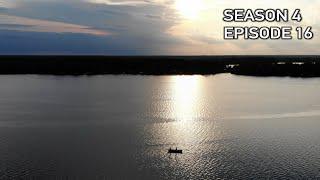Cast, after cast, after cast… we take thousands of casts during a full day of muskie hunting and many times we are throwing multiple casts to the SAME EXACT AREA or spot. Why? Well, that is a good question that many anglers might ask! Insanity? At times, one might argue yes! But not all of the time. Let me explain why!
In season 4 – episode 16 my good friend and fishing partner Mike Richardson and I were fishing a favorite rock reef of ours and we had circled it once, hitting “every spot” on an effective trip around the structure. But we came up empty handed. I have to admit, I was a little bummed and surprised by this because I was feeling very confident that the reef in question was indeed holding a musky. And that is sometimes the key behind the persistence that must be maintained at times to score in the “Esox World.”
Even with pervasive and perfect casting, with multiple lures being worked over a small area, the fact still stands that the “entire” spot has NOT been “covered.” It all depends on a musky’s activity level! (although many other factors likely contribute simultaneously to what we might call the “strike zone”). Picture an aggressive muskie sitting on the prime spot on some piece of structure. Any lure that comes within, let’s say 5 ft of its snout, gets picked off and devoured! Now let’s say that under challenging environmental conditions that same musky’s “strike zone” has diminished to a mere 5 inches around its snout. Now THAT, is a hard place to land a lure. You could circle a reef many times over and NEVER hit that spot. It is just that hard to do.
So if you’re still reading this you might think that I am telling you to “camp” on a spot and cast until the “cows come home” so that you can trigger a strike from a negative-mood ski. But you would be interpreting the wrong message! Doing this could, and many times is, a waste of time during the course of your fishing day. What I am saying though, is that you must hedge your bets. When the evidence is stacking in your favor in a way that says, “keep casting… your chances are still high for triggering a strike,” then you should keep casting a little while longer. If you have collected enough evidence that says, “you have exhausted your options… move onward,” then you should pickup and carry-on my wayward son!
Figuring out when to “pull the plug” and when to stay and focus your efforts is a hard thing to gauge. Arguably it is time on the water that often lets expert anglers know when it is time to lay the hammer down or when it is time to gun the throttle. But there are other instruments that can help you determine fight-or-flight on the spot you are fishing!
For example, understanding how to read your electronics can pay huge dividends for the angler who is looking to know more about what is going on under the water’s surface. Does your locator show the presence of baitfish? Does your Side Imaging display the shadow of a musky nearby or off in the distance? If the answers to any of these questions was yes, then you might consider staying on a spot a little longer to investigate! Perhaps that muskie off in the distance is a member of a wolf-pack that is working the particular spot you are fishing and thus, one of the other more aggressive members of the pack could still be hiding in ambush on the spot.
Another factor that can influence an angler’s interest in “saying to cast longer” on a particular structure could be environmental change. For example, if you are fishing a “hump” during a pre-storm period in which barometric pressure, light and wind change are high, one might expect that only a few casts are needed to see if a hungry musky is going to pounce on your TopRaider! And then take this same “hump” on a different day, such as during a cold front when the barometer is not moving at all, and you might expect that muskies holding on the structure are less likely to attack. Given you are fishing a prime spot during challenging environmental conditions would you decide to stay a little longer to see if you could TRIGGER a strike?
This exact scenario is what played out for my buddy Mike and I as we casted one of our favorite rock humps. The environmental conditions were “less than ideal” and we had not seen a musky ALL DAY! So after circling the rock structure once, and finding no success, we opted to invest more time to see if we could trigger a reaction strike from a muskie we “knew” was holding there. With just the right cast my baby DepthRaider ticked a rock next to a musky’s jaws and it was GAME ON! Many times our additional efforts do not produce the results we are looking for but sometimes, with the right amount of persistence, the Musky God’s shine down and reward us for intuitive thinking, muscle strain and staying in the game!




